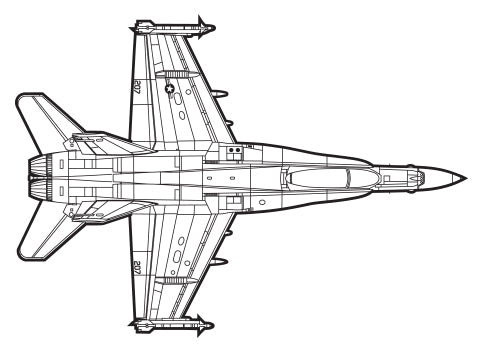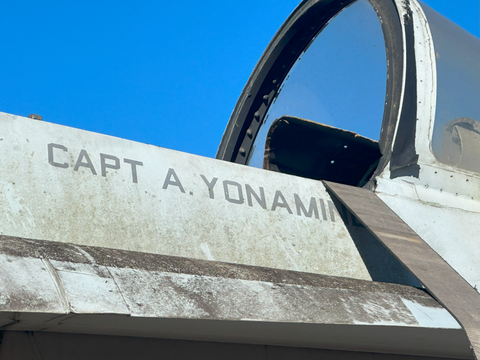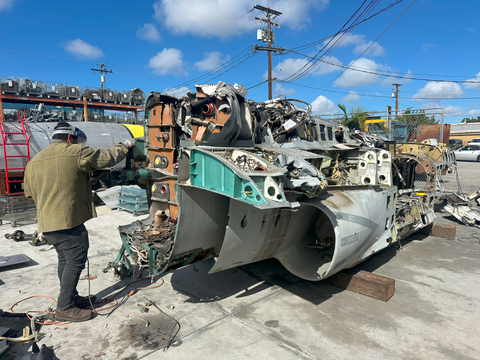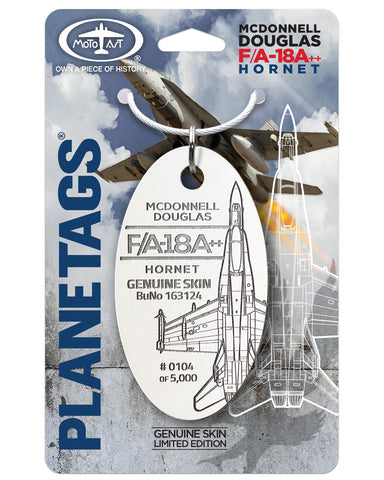
- by Dianna Lopez
F-18 Hornet: The Story of an Aviation Legend
- by Dianna Lopez
A question? Visit our contact page
This site uses cookies for better user experience and analytics.

The F-18 is not just any fighter jet; it's a true icon of military might and technological prowess. MotoArt has preserved the story of one F/A-18A++, BuNo 163124, and has given it an opportunity to live on in a unique way. Read more about this legendary aircraft, then add a piece of history to your collection on February 22, 2024 at planetags.com.

The history of the F/A-18 Hornet begins in the 1970s, a period marked by rapid technological advancements and shifting military defense strategies. The U.S. Navy and Marine Corps were in the market for a new, versatile, carrier-capable fighter jet, able to fulfill both air-to-air combat and ground attack roles. This need was driven by the desire to replace older aircraft, and to adapt to the changing dynamics of aerial warfare, which demanded greater agility, reliability, and multirole capabilities.
The initial design and development of the F-18 were heavily influenced by the experience gained from the Vietnam War and the evolving expectations of modern combat. The project, initially known as the Naval Fighter Attack Experimental (VFAX) program, sought to produce a fighter that could achieve air superiority and strike ground targets effectively, a concept that would eventually materialize as the F/A-18 Hornet.

By USN - U.S. Navy Naval Aviation News [1] March-April 2009, p. 20., Public Domain, Link
The competition for what would become the F/A-18 was intense, with several aerospace companies vying to meet the Navy's stringent requirements. The story took a significant turn with the Northrop YF-17 Cobra, a prototype aircraft initially designed for the U.S. Air Force's Lightweight Fighter (LWF) program. Although the YF-17 was not selected for the Air Force, its design caught the attention of the Navy as a potential basis for their new multirole fighter. The YF-17's excellent agility, speed, and advanced technology made it a compelling candidate for further development.

In partnership with McDonnell Douglas (now part of Boeing), Northrop significantly upgraded the YF-17 design to meet the Navy's needs. This collaboration resulted in the F/A-18 Hornet, which incorporated twin engines for reliability and redundancy, advanced avionics for multirole missions, and the capability to launch from and land on aircraft carriers. The development process involved a series of design iterations, extensive testing, and validation to ensure the aircraft could fulfill its intended roles effectively.
The selection of the F/A-18 Hornet was the culmination of a rigorous evaluation process, underscoring its superior design, versatility, and adaptability. From its origins as the YF-17 Cobra, the F-18 evolved into a cornerstone of American naval aviation, setting a new standard for multirole fighter jets. Its development not only reflects the technological advancements of its time but also the strategic vision that continues to shape modern aerial warfare and defense strategies.

The difference between the F-18 Hornet and the F-18 Super Hornet is rooted in their design, capabilities, and roles. The Super Hornet, encompassing the F/A-18E (single-seat) and F/A-18F (two-seat) variants, is not just an upgrade but a larger, more advanced version of the original F/A-18 Hornet. It boasts approximately 25% more surface area, significantly improved range and endurance, and a greater payload capacity, allowing it to carry more weapons and fuel. The Super Hornet features state-of-the-art avionics, including enhanced radar systems and survivability equipment, making it more effective in both air-to-air combat and air-to-ground missions. Additionally, the Super Hornet's engines provide more thrust, improving its performance and carrier launch capability.

The introduction and continued evolution of the F/A-18E/F Super Hornet have been pivotal in allowing the F-18 platform to remain a cornerstone of U.S. Navy aviation into the current times. By addressing the limitations of earlier models and incorporating the latest in military aviation technology, the Super Hornet has not only extended the service life of the F-18 series but has also ensured that it continues to be a critical asset for achieving air superiority and supporting ground forces in conflicts around the world.
The operational history of the F/A-18 Hornet spans several decades, making it one of the most versatile and reliable combat aircraft in the world. Since its introduction into service with the U.S. Navy and Marine Corps in the early 1980s, the Hornet has played a pivotal role in numerous military operations, showcasing its capabilities in both air-to-air combat and precision strike missions. Its first major combat test came during the 1986 Operation El Dorado Canyon, where Hornets flew strike missions against Libyan targets, demonstrating their precision and operational effectiveness. However, it was the 1991 Gulf War that truly highlighted the Hornet's multirole functionality, as it successfully conducted both fighter and attack missions, engaging enemy aircraft and hitting ground targets with high accuracy.

Beyond its combat roles, the F/A-18 has been a key asset in enforcing no-fly zones over Bosnia, Iraq, and Libya, participating in both Operation Southern Watch and Operation Iraqi Freedom. In these conflicts, Hornets were instrumental in carrying out air superiority missions, close air support, and strategic bombing, often in challenging environments and against a backdrop of sophisticated enemy air defenses. The Hornet's ability to adapt to various mission types, from reconnaissance to suppression of enemy air defenses (SEAD), further underscores its operational flexibility. Moreover, the F/A-18 has not been limited to U.S. service; it has been adopted by the armed forces of several other countries, including Australia, Canada, Finland, Malaysia, Spain, and Switzerland, among others, each utilizing the aircraft's extensive capabilities to fulfill their national defense needs.

Photo taken May 18, 2012 at Andrews AFB by Mark Carlisle. Used with permission.
Our plane, cn 0528 (A437) was constructed as an F/A-18A-20-MC (Lot 9) by McDonnell Douglas, later converted to a F/A-18A++. Circa 1986 it became BuNo 163124 and embarked on a military career that took it all over the world. Throughout its mission, 163124 served with various squadrons, including VFA-15 “Valions”; aboard the USS Theodore Roosevelt during Desert Shield, the VMFA-312 “Checkerboards,” and finally, the VMFA-115 “Silver Eagles” before being retired.

The VFA-15 Valions was a U.S. Navy strike fighter squadron. Established on May 1, 1945, the squadron has a long and distinguished history, flying the F4U Corsair, F8F Bearcat, F9F Panther/Cougar, and F-4 Phantom II as well as the F/A-18 Hornet. The Hornets were a significant part of the squadron's operations, enabling them to execute a variety of missions, including air-to-air combat, ground attack, and reconnaissance missions in support of U.S. Navy objectives.
From December 1985 to June 1986, the VA-15 squadron was assigned to the 1st Marine Air Wing, MCAS Iwakuni, Japan for a six month deployment to test interoperability between Navy and Marine squadrons. In October 1986, they were redesignated VFA-15, Strike Fighter Squadron 15. With VFA-15, BuNo 163124 served aboard USS Theodore Roosevelt and was deployed to the Persian Gulf in support of Operation Desert Shield.
 Photo by Mike Egan, used with permission.
Photo by Mike Egan, used with permission.

Marine Fighter Attack Squadron 312 (VMFA-312), known as the "Checkerboards," is a distinguished unit within the U.S. Marine Corps that operates the F/A-18 Hornet. Established on June 1, 1943, VMFA-312’s history spans several decades and includes participation in key conflicts and operations, from World War II to the present day. The squadron is named for its distinctive checkerboard tail markings, making its aircraft easily recognizable.
The transition to the F/A-18 Hornet marked a significant evolution in VMFA-312's operational capabilities. The Hornet's multirole functionality allows the "Checkerboards" to execute a wide range of mission profiles, including air-to-air combat, ground attack, close air support, and reconnaissance missions. This versatility ensures that VMFA-312 can effectively support Marine Corps operations wherever air power is needed.
The "Checkerboards" are based at Marine Corps Air Station Beaufort in South Carolina, where they continue to train and prepare for future challenges. As part of the Marine Aircraft Group 31 (MAG-31) and the 2nd Marine Aircraft Wing (2nd MAW), VMFA-312 plays a vital role in upholding the United States' commitment to global security and demonstrates the enduring value of the F/A-18 Hornet to Marine Corps aviation.
Marine Fighter Attack Squadron 115 (VMFA-115), known as the "Silver Eagles," was established on July 1, 1943 and are based at Marine Corps Air Station Beaufort in South Carolina, part of Marine Aircraft Group 31 (MAG-31) within the 2nd Marine Aircraft Wing (2nd MAW).

The Silver Eagles have flown several different aircraft types since their establishment in 1943. Over the decades, VMFA-115 has transitioned through various aircraft as advancements in aviation technology have evolved, including:

The squadron has been involved in pivotal actions in the Middle East, including Operations Desert Storm, Iraqi Freedom, and Enduring Freedom, where its Hornets have been instrumental in achieving mission success through precision strikes and air superiority.

MotoArt owner Dave Hall has had the F-18 Hornet on his mind for over 20 years, however finding one was not an easy task. In 2023, Hall and long time associate Doug Scroggins found themselves with an F-18 and an opportunity to tell its story in more than one way.

Scroggins Aviation Mock Up & Effects, led by its founder Doug Scroggins, and MotoArt, under the leadership of Dave Hall, share a unique and longstanding collaboration that spans over two decades. Both leaders, through their respective companies, have dedicated themselves to the preservation of aviation history, working hand-in-hand on several projects to salvage and restore iconic aircraft. Their joint efforts on aircraft such as the UH-46D Sea Knight and Delta L-1011 Tristar are a testament to their mutual respect and shared passion for aviation.

In the case of BuNo 163124, Scroggins Aviation is meticulously restoring the cockpit section, bringing it back to its former glory, where it will live on as a Hollywood movie prop. The back two thirds of the plane was dedicated to PlaneTags, offering aviation enthusiasts a tangible piece of its history. Their partnership not only preserves the legacy of these magnificent flying machines but also ensures that the spirit of aviation continues to inspire future generations.

The crew brought the rear portion of the derelict aircraft back to MotoArt headquarters in Torrance, California in early 2024. The skin was removed to create F-18 PlaneTags.






McDonnell Douglas F/A-18A Hornet PlaneTags will be available on planetags.com beginning at noon Pacific Time Thursday, February 22, 2024. They are numbered in a series of 5,000 tags.





Don't miss your chance to own a piece of aviation history. The F-18 Hornet is a rare gem, and our PlaneTags crafted from this iconic aircraft offer you a unique opportunity to hold a piece of its legacy in your hand. Be ready to act fast when they go on sale this Thursday, as these limited edition PlaneTags are expected to fly off the shelves.
Don't miss these other incredible fighter planes for your PlaneTags collection, made with the genuine skin of decommissioned aircraft.
N466FE “Gideon”: The FedEx Boeing 727 That Kept the World Moving
From Warbird to Water Bomber: The Epic Life of the Hawaii Mars
In the world of aviation, few aircraft have lived a life as large, or as long, as the Hawaii Mars. Towering over most of its contemporaries with a wingspan of 200 feet, this mighty flying boat was born in the final days of World War II, then quietly transformed into one of the most iconic aerial firefighting aircraft the world has ever seen. From military transport to firefighting titan, the Hawaii Mars represents one of aviation’s most extraordinary second acts.
In 2025, MotoArt obtained an original wing of this aircraft and created special PlaneTags, made exclusively for the Martin family members and Mars workers. On December 11, 2025, Hawaii Mars PlaneTags will be available to the general public for the first time.
F-14 Tomcat Coasters: A Legendary Fighter Reimagined for Your Home
Few aircraft define an era quite like the Grumman F-14 Tomcat. Sleek, powerful, and unmistakably iconic, the Tomcat was the Navy’s premier fleet defense fighter for more than three decades. From Cold War missions to pop culture stardom, the F-14 remains one of the most recognizable and beloved aircraft ever built. Today, MotoArt is proud to introduce the F-14 Tomcat Coaster Set, created from authentic F-14 aircraft material.


Share:
Soaring Together: Sun Country Airlines and Boeing 737
United Airlines 727: An Icon of the Skies